“The Apple”
Written by Max Ehrlich
Directed by Joseph Pevney
Season 2, Episode 9
Production episode 60338
Original air date: October 13, 1967
Stardate: 3715.3
Captain’s log. The Enterprise is in orbit of Gamma Trianguli VI, under orders to make contact with the natives, and also to make sense of some odd readings taken by nearby scout ships. A landing party beams down that includes Kirk, Spock, McCoy, Chekov, Yeoman Martha Landon, and four security guards: Hendorff, Marple, Mallory, and Kaplan. Spock comments on how the planet has fairly even, pleasant temperatures and a great deal of plant growth all over the planet, even at the poles, which is bizarre to say the least.
A flower starts turning on its own. Hendorff goes to investigate it, and is hit with a barrage of spores that kill him instantly. Kirk reports in to Scotty, in charge of the Enterprise, who beams the body back. Scotty also reports that the antimatter pods are losing potency, and they’re detecting an odd electromagnetic field on the planet. Spock, meanwhile, reports that there’s a consistent, artificially created subsurface vibration, and it covers the entire planet.
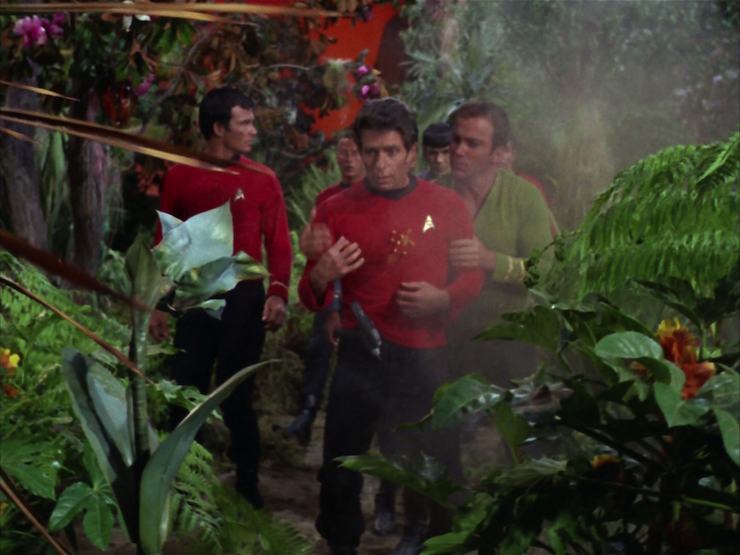
Kirk sends Marple and Mallory to scout the village they were heading toward. Meanwhile, Spock finds a scout of his own: a local who is checking them out while in hiding. Kirk decides to let him be for the moment, and the party moves more slowly toward the village. Spock finds a rock sample that he finds fascinating. He tosses one piece aside, and it explodes.
Scotty reports that the antimatter is now wholly inert, and the source is an emission from the planet that seems to be centralized in the village they’re headed to.
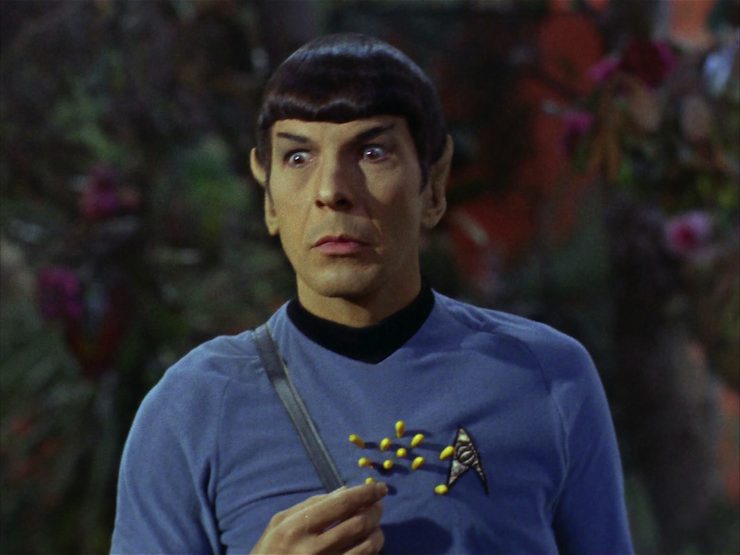
Another flower attacks Spock, but he doesn’t die instantly, due to his being in the opening credits. McCoy might be able to save him in sickbay, but when Kirk calls for a beam-out, Scotty discovers that the transporter has lost power. However, Spock recovers completely anyhow, thanks to a hypo McCoy injects him with, so that’s a relief. Why Hendorff didn’t get such an injection is left as an exercise for the viewer.
Suddenly a major electrical storm hits. Lightning fries Kaplan, and the rest of the landing party takes cover. The storm passes as quickly as it came.
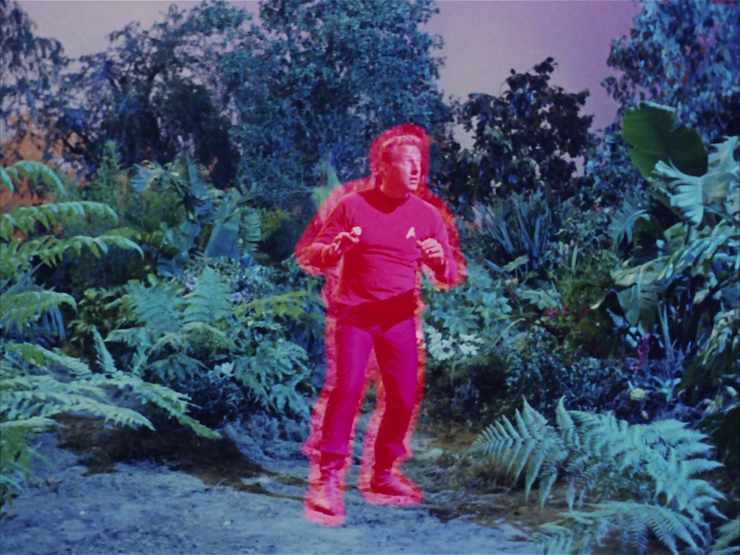
Mallory reports in that he’s reached the village, but the communication is garbled. He reports that the village is primitive: straw huts and no noticeable technology. However, his report doesn’t make it through the interference—they did get his coordinates, though, and what’s left of the landing party heads that way.
They encounter Mallory and Marple running away from the village, and Mallory trips on one of the explosive rocks and is killed. Kirk is getting seriously pissed off: this isn’t an important enough mission to justify three deaths.
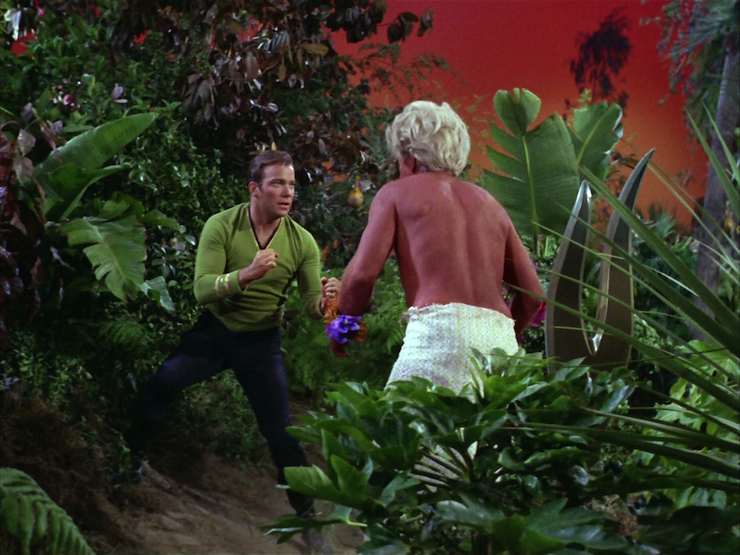
Spock detects their pursuer again, and this time the landing party lures him into the open. Kirk punches him, and the man starts crying. His name is Akuta, he is the leader of the Feeders of Vaal, and he’s only wearing a serape. He also has antennae behind his ears, which Akuta explains are the Ears of Vaal. He offers to take the party to Vaal.
Scotty reports that something like a tractor beam is pulling the Enterprise toward the planet, and without warp power, they can’t break free of it.
Akuta explains that Vaal makes the sun shine and the rains pour. All things come from Vaal. He leads them to a cave mouth shaped like a huge animal head. Spock’s tricorder tells him that this is an access point for the power source, which is deep beneath the surface. It’s also surrounded by a force field, which Spock discovers when said field knocks him on his ass.
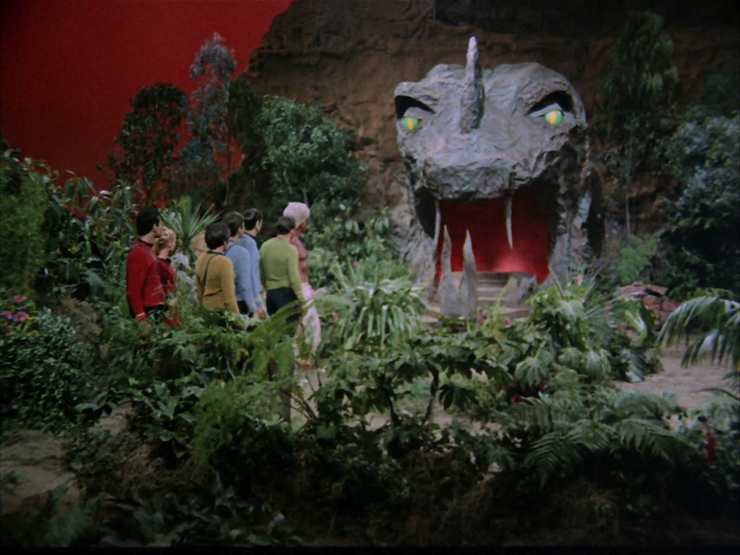
Akuta says that Vaal is sleeping now, but he may speak to Kirk when he awakens and is hungry. He takes the party to the village. Kirk is confused by the lack of children, but Akuta says that “replacements” aren’t necessary, and he also informs Landon that Vaal has forbidden intimacy. They wrap flowers around everyone’s wrists, give them a hut to stay in, and provide food and drink.
McCoy reports a complete lack of harmful bacteria, no cellular degeneration, no signs whatsoever of aging. He can’t tell how old they are. Spock adds that their atmosphere protects them from all harmful effects of the sun, and they have a controlled diet and regulated temperature. In some ways it is paradise, except for the whole part about flowers and rocks that can kill you.
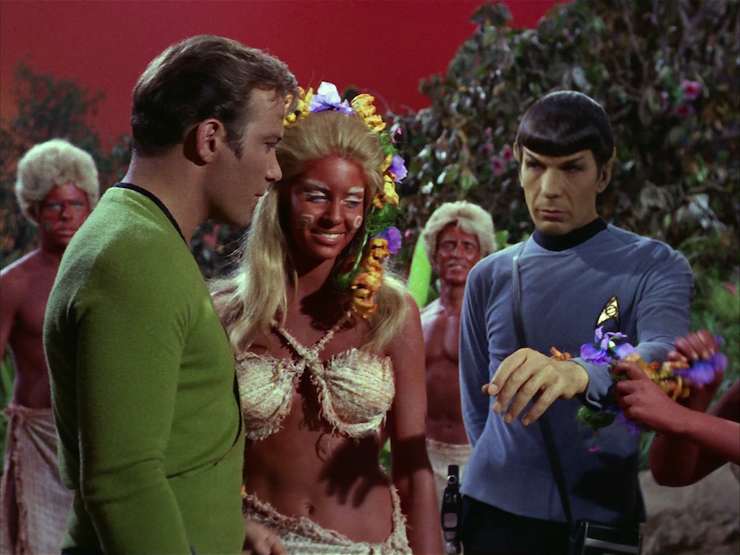
The villagers all suddenly gather at Vaal and provide offerings. But when Kirk and Spock try to approach, the eyes start to glow.
Kirk has Scotty do an analysis of the electromagnetic energy expended by Vaal hour by hour, and Scotty says that there’s been a continuous drop in power. Spock and McCoy argue on the subject of this society—Spock finds it orderly and points out that the people are happy and healthy, while McCoy argues that it hasn’t changed in millennia, and it’s not life, it’s stagnation in the service of a hunk of tin.
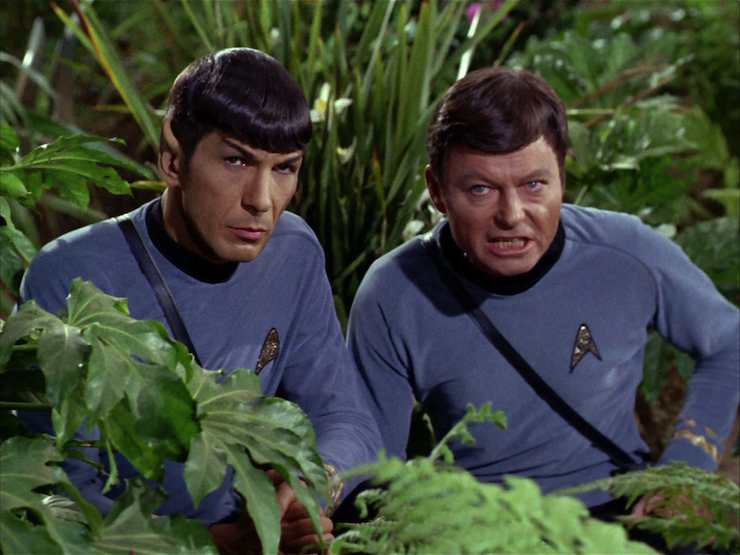
The landing party gathers in their hut to eat. Kirk wonders what they do if someone dies, and Landon wonders how they would create a replacement, as it were, when they don’t ever seem to have sex. (This particular scene takes forever, since 1967 Broadcast Standards & Practices only allowed for innuendo and hints and tee-hee speculating on the subject.)
Later, Chekov and Landon wander about and make sweet, passionate nookie-nookie. Sayana and Makora, two of the locals, watch this in confusion. They decide to try kissing also to see what all the fuss is about. Akuta catches them and reprimands them. Vaal informs Akuta that the strangers are dangerous and he orders Makora to gather the men of Vaal in a clearing. Vaal has instructed the men to kill the strangers, which is a concept they’re wholly unfamiliar with. Akuta has to demonstrate how to kill using a big stick and a fruit (representing a head), which he then smashes.
Everyone’s asleep except for Kirk and Spock, who discuss the efficacy of destroying Vaal and what it might do to these people. Spock mentions the Prime Directive, but Kirk agrees with McCoy: these people deserve a choice in how to live their lives.
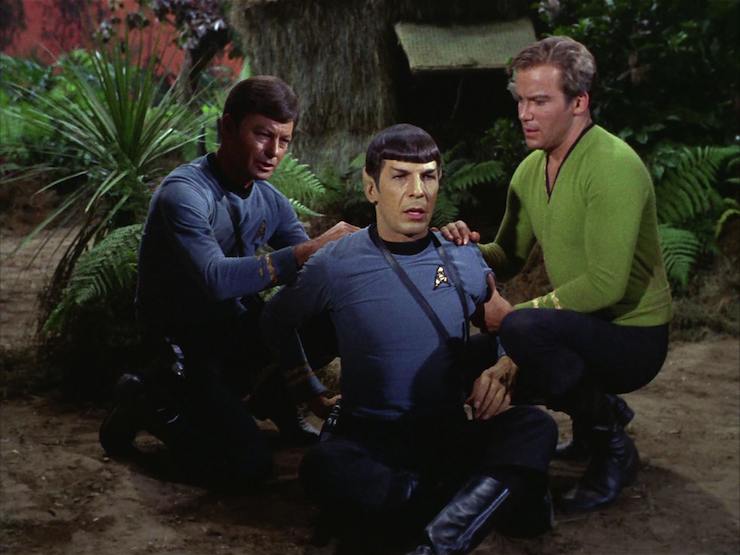
Spock then reports that the people of the village have disappeared. He and Kirk go to Vaal and try to confront it, but then another nasty electrical storm hits. Spock is struck by lightning, just like Kaplan, but unlike Kaplan, he still has the power of being in the opening credits, and so he’s only singed.
The men of the village attack with big sticks. Marple is killed, thanks to the element of surprise, but the rest of the party hold them off with ease. (Of particular note is that Landon kicks some serious ass in the fight.)
Scotty pulls an engineering rabbit out of his hat, but it only gains the Enterprise an hour or so before they’ll get drawn into the atmosphere and burned up.
Vaal calls for feeding, and the natives all try to go to feed him, but Chekov orders them to stay put. Kirk orders him, McCoy, and Landon to keep the people in the hut. Akuta begs them to let him and the others go.
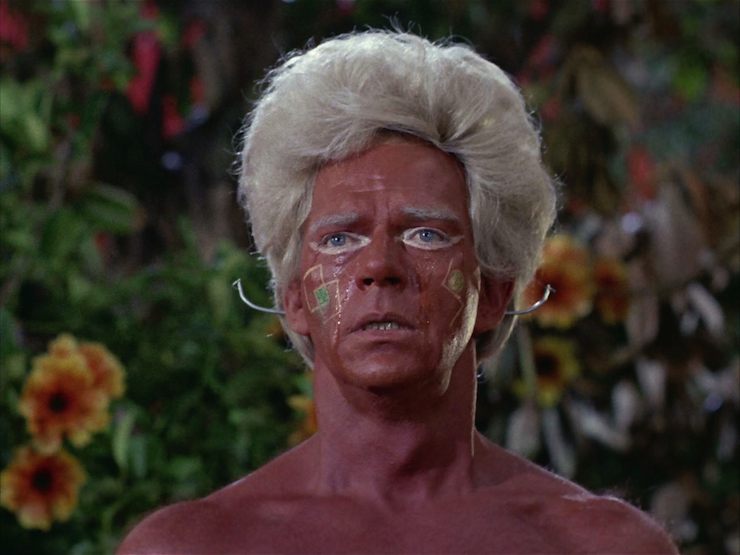
Kirk hypothesizes that the Enterprise‘s attempt to break free drained its reserves, which is why it called for feeding. The ship’s phasers are still working fine, so Kirk orders Scotty to fire on Vaal. It can’t get through the force field, but it proves a further drain on Vaal’s resources. Eventually, the continuous phaser fire overcomes it, and Vaal goes dark. Spock finds no power emissions whatsoever, and Scotty reports that the Enterprise antimatter pods have regained power.
Akuta is devastated: Vaal cared for them, put fruit on the trees, made it rain. Kirk insists that they can put fruit on the trees themselves, and they can also enjoy love and affectionate, and other family values.
Spock is still unsure of whether or not they did the right thing. He makes mention of the story told in Chapter 1 of Genesis, prompting Kirk and McCoy to joke that there’s only one person on the ship who resembles Satan, and everyone has a laugh (except Spock).
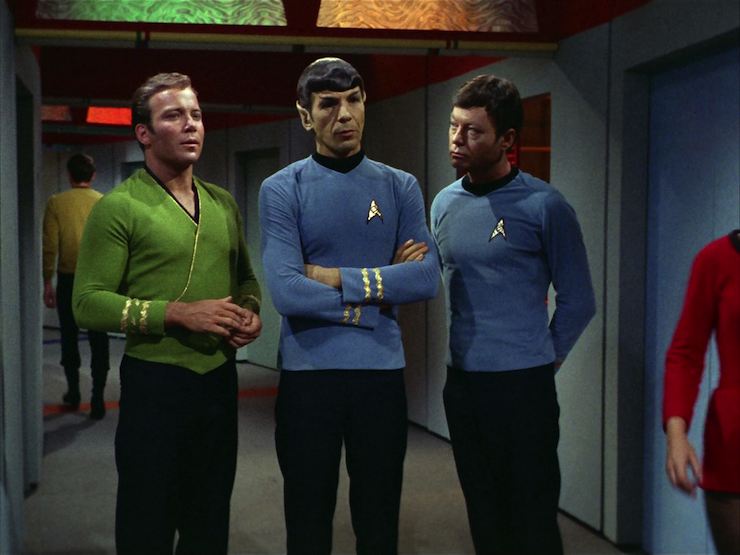
Can’t we just reverse the polarity? With the antimatter pods rendered inert, the Enterprise doesn’t have warp power, and impulse power is insufficient to break Vaal’s hold. Scotty does reroute some circuits to increase power to the impulse engines, but it’s only enough to buy them a little extra time—luckily, it also drains Vaal’s power enough for Kirk to work his endgame.
Fascinating. Spock starts to enumerate how much Starfleet has invested in him to Kirk, but only gets as far as “one hundred twenty-two thousand, two hundred” before he’s cut off. We don’t get to learn the full amount, nor the currency in which he’s valuing himself (heck, he could even be reeling off the amount of time he spent training for all we know).
He also is attacked in exactly the same manner as two of the redshirts who are killed, and he not only survives, but shows no ill effects from either attack within fourteen seconds of being so attacked.
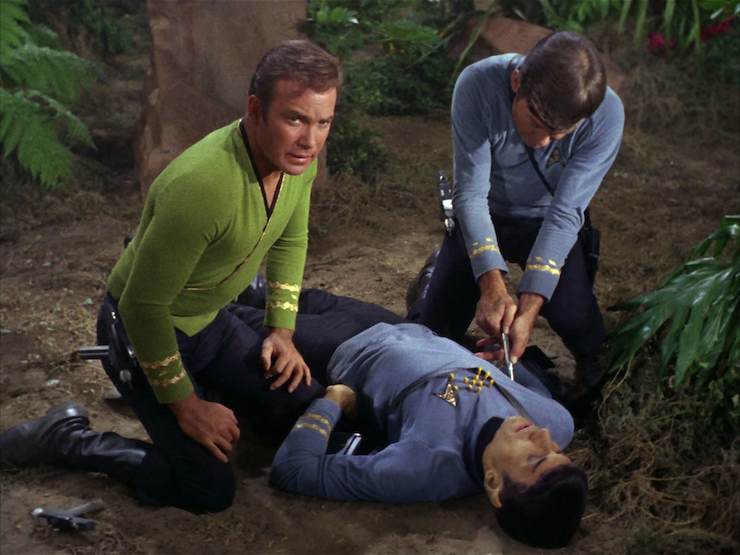
I’m a doctor not an escalator. When Hendorff is attacked by the spores, McCoy throws up his hands and says, “He’s dead, Jim.” When Spock is attacked by the spores, McCoy pulls out a hypo and injects him with it. Yeah.
I cannot change the laws of physics! Scotty is left in charge of the ship and does lots of things to try to fix it, pretty much all of which fail.
It’s a Russian invention. Chekov insists that the Garden of Eden was located just outside Moscow.
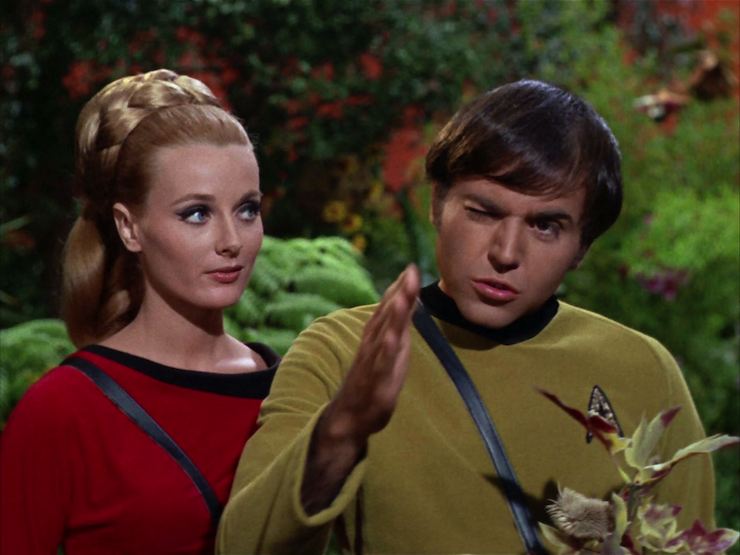
Go put on a red shirt. All four security guards who beam down are systematically killed, either by accident (Hendorff, Mallory) or due to Vaal’s direct actions (Kaplan, Marple). Nobody else is even badly hurt.
No sex, please, we’re Starfleet. Chekov and Landon are dating (Landon even calls him “Pav”), and they go all smoochie-face at one point, which inspires two of Vaal’s followers to do likewise.
Channel open. “Would you mind being careful where you throw your rocks, Mr. Spock?”
Kirk criticizing Spock’s cavalier method of tossing explosive geological samples around.
Welcome aboard. Celeste Yarnall plays Landon, the latest member of the Post-Rand Yeoman Derby, while Keith Andes, David Soul, and Shari Nims played the three Vaalians with speaking parts. The four redshirts who are killed are played by Jay Jones (last seen as Jackson in “Catspaw“), Jerry Daniels, Mal Friedman, and Dick Dial (like Jones, a regular stuntman for the show; he’d also come back to the franchise decades later, playing Jeremy Kemp’s stunt double in TNG‘s “Family“). Plus we have recurring regulars James Doohan, Walter Koenig, and John Winston.
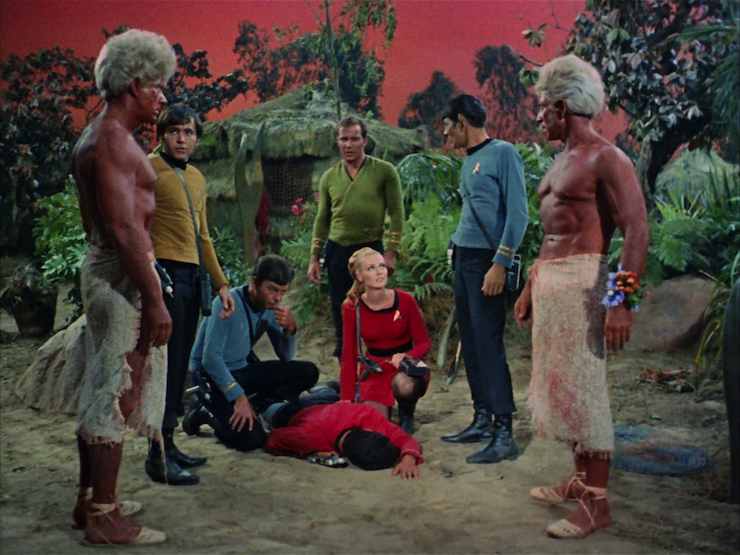
Trivial matters: Gene L. Coon did an uncredited rewrite of the script.
Kirk said that Mallory’s father helped him get into Starfleet Academy. This was dramatized in the novel Collision Course by William Shatner, with Judith & Garfield Reeves-Stevens.
DC Comics’s first monthly Star Trek series did a sequel to this episode in issues #43-45 by Michael Carlin, Tom Sutton, & Ricardo Villagran, which had the Enterprise-A revisiting the world to see how they’d progressed. (Spoiler: they progressed very very very badly.) Vaal also appears, and is encountered by a time-travelling Seven of Nine, in Greg Cox’s novel No Time Like the Past.
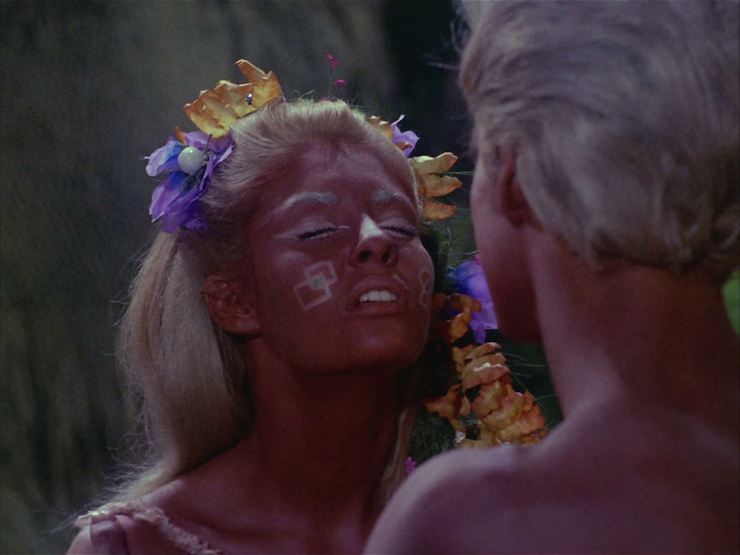
IDW’s current monthly Trek comic did a version of this story in the alternate timeline of the 2009 film, done from the point of view of Hendorff. It was issue #13 by Mike Johnson & Stephen Molnar, and in that timeline, the redshirts all survive the mission. That comic also establishes that “Cupcake” from the film was that timeline’s Hendorff.
The original script called for the Enterprise to separate the saucer from the rest of the ship, something that was originally listed as a feature of the ship in the series writers guide, but it was deemed too expensive. (Kirk does, at least, mention it when discussing options with Scotty.) Saucer separation would become an overtly stated feature of the Enterprise-D in TNG, seen in “Encounter at Farpoint,” “The Arsenal of Freedom,” and “The Best of Both Worlds, Part II.”
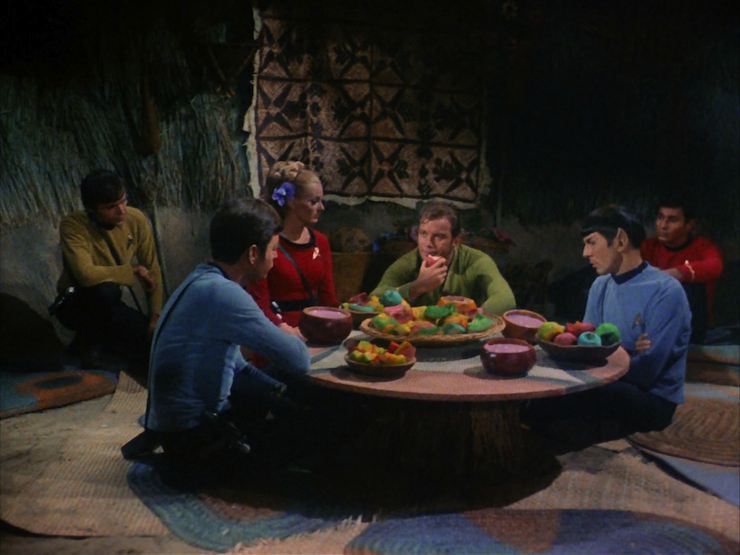
Celeste Yarnall was actually wearing Grace Lee Whitney’s old costume on set, which was retailored to fit her.
This is the only Trek work by author/screenwriter/journalist Max Ehrlich, who is probably best known for writing the 1973 novel The Reincarnation of Peter Proud as well as the screenplay for its movie adaptation in 1975.
To boldly go. “Garden of Eden, with land mines.” How many clichés can we wrap into one episode? Let me count the ways…
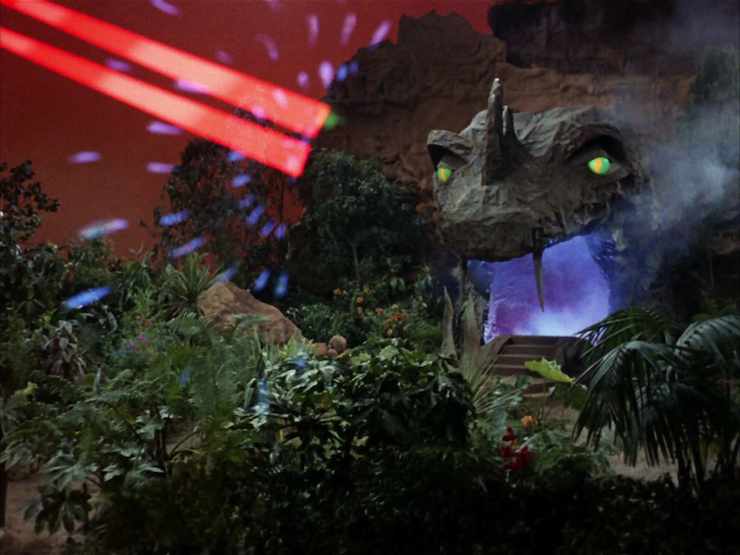
First, we get the world-running computer. We’ve seen this before, in “The Return of the Archons,” and this has pretty much the same beats, with just minor variations. “The Apple” has a higher body count and the people controlled by the computer are far less technologically advanced (and there are fewer of them), but it’s basically the same story. The one thing this episode has over the first-season one (as well as “The Changeling“) is that the computer isn’t done in by Kirk’s rhetorical brilliance (ahem) but rather by simply overpowering it.
Second, we have the common Trek theme of things seldom being what they seem. But where that can be used to good effect—”Arena,” “The Corbomite Manuever,” “The Devil in the Dark“—it’s less effective when you do the metaphorical rug-pulling before the opening credits have even rolled.
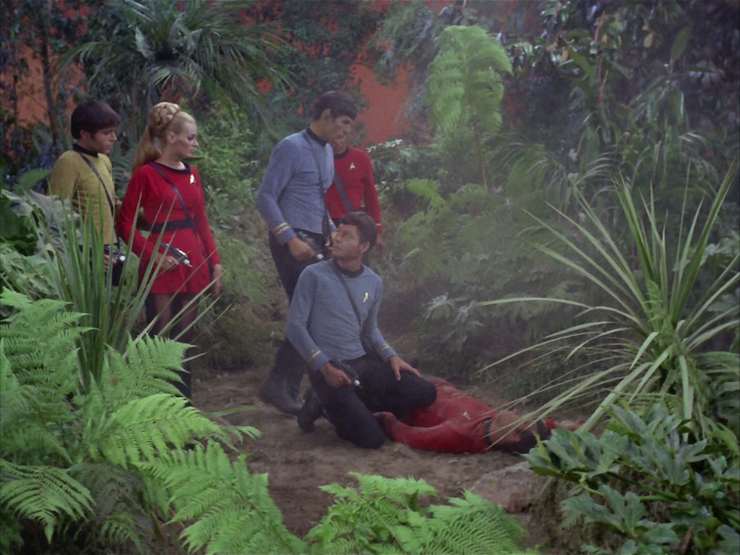
Third, we have the Redshirt Phenomenon, inaugurated in “What Are Little Girls Made Of?” seen again in “Friday’s Child,” and taken to its absurd extreme for the second episode in a row, as we get four walking talking corpses, although unlike Nomad’s victims in “The Changeling,” these four at least a) get names and b) get to die in a variety of ways. What makes it far more appalling, though, is that Spock survives two like attacks without any ill effects whatsoever. Spores that kill Hendorff instantly somehow don’t kill Spock, and after an injection from McCoy, all he has is a tummyache. And when he’s hit by lightning, he has second-degree burns that are described as very painful, and then he shows no signs of injury in the least after that. Not even a damaged shirt! I guess Vulcans have more hit points…
Fourth, we get the ship in danger until the last second when Scotty pulls an engineering rabbit out of his hat after bitching the whole episode about how there’s nothing he can do. This got its start in “The Naked Time,” and also is one of the most extreme examples.
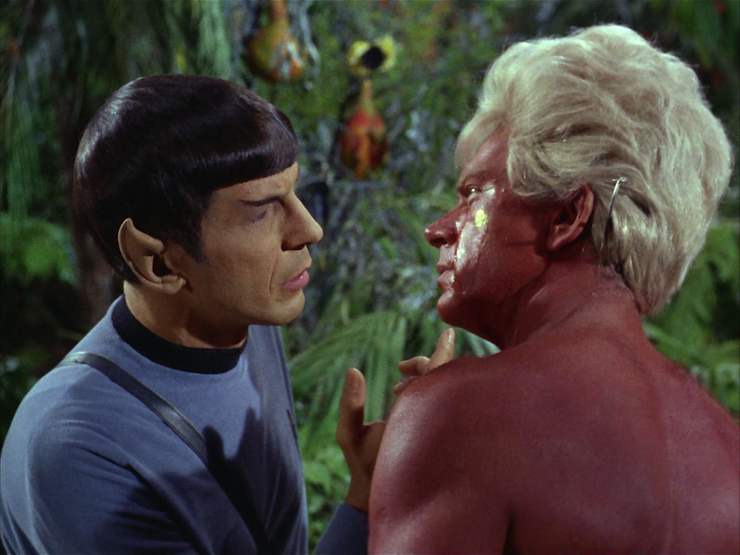
On top of that, the plot is just irritating on so many levels. Probably the biggest issue, though, is this: why does this planet, that has been tailor-made to keep the natives happy and immortal and unchanging so they can feed Vaal, have poisonous flowers and exploding rocks? Supposedly Vaal is out to protect the natives so they can keep feeding him, but what if they, like Mallory, trip on a rock? Or walk in front of the wrong flower?
This is also the kind of story where what happens next is at least as important as what happened. This is a society of people who have no clue how to fend for themselves. One assumes they had Federation assistance, but how did they survive the transition? What happened when someone got sick? Or committed a crime?
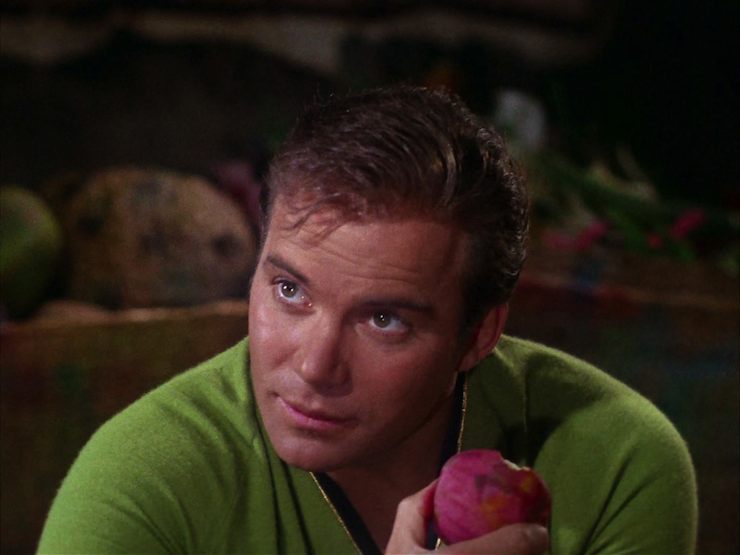
Warp factor rating: 3
Next week: “Mirror, Mirror”
Keith R.A. DeCandido wishes everyone a joyous holiday.










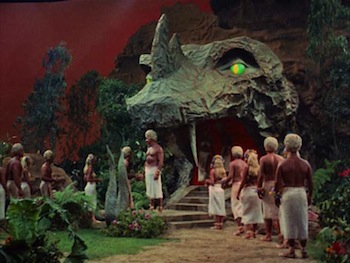
This is definitely the most gratuitous redshirt-death episode. I mean, sure, we get high death counts in “The Changeling” and “Obsession,” but what’s particularly ludicrous about this one is that they actually beam down ten people, needing two separate transporter cycles, simply so that there will be a lot of supernumeraries to kill off. In no other episode do they beam down more than six people at one time, so it’s extra-blatant that the redshirts were specifically there to be killed off one by one. It’s just so completely self-indulgent.
By the way, the identification of “Cupcake” as Hendorff was made explicit in Star Trek Into Darkness. No doubt the comic writers already knew that the movie would be doing that, which is why they were able to give him that name first. (Movies take far longer to make than comics.)
The high point here, though, is Martha Landon. As TOS yeomen go, she’s pretty kickass, getting to participate in the big fight and making an excellent showing of herself. Okay, granted, she’s fighting against pacifists with zero prior combat experience, but still, she gets some pretty cool moves. It’s quite rare for a female character to get in on the action like this in TOS — the only other instance that comes to mind is Uhura vs. Marlena in “Mirror, Mirror.”
On the exploding rocks: One thing that was never really apparent until the episodes were remastered in high-definition is that the offerings that the Vaalians fed to Vaal, which I and a lot of viewers always assumed to be fruits and the like, were actually the exploding rocks. The James Blish adaptation gets this right, at least mentioning that the offerings were rocks, so I guess we should’ve known all along. Anyway, the rocks were evidently supposed to be Vaal’s power source, and the natives collected them to feed Vaal. One has to wonder why the rocks were just lying around, though. Surely in hundreds or thousands of years of feeding Vaal, the natives would’ve exhausted the supply of loose rocks in the area and would have needed to mine for them.
I probably mentioned in the “Who Mourns for Adonais?” rewatch comments that this episode’s climax uses the same Fred Steiner music composed for that episode’s climax, since they’re basically the same climax — the Enterprise firing phasers at a “god” until it loses power and frees the ship. I like to think that Star Trek generally doesn’t show brute force as the solution to its problems, but I guess sometimes it does.
He also is attacked in exactly the same manner as two of the redshirts who are killed, and he not only survives….
He’s Spock! Vulcan stamina and whatnot… “hit points,” as you say. Surely it’s been well-established by this point in the series that Vulcans are stronger than humans (he said, knowing full well that this rewatch has challenged plenty of things he “surely” thought were established in Trek lore…)
And maybe McCoy had special first aid for Vulcans… maybe….?
On saucer separation: Someone on another Internet forum somewhere gave me a lot of grief about this years ago, so that which I have received, I now hand on to you: Is Kirk actually referring to what TNG will establish as “saucer separation” when he tells Scotty, “Discard the warp drive nacelles if you have to, and crack out of there with the main section, but get that ship out of there!” Sounds like he’s talking about a last ditch emergency maneuver, not a “plan B” built into the ship. I know it was mentioned in the original series Bible, but based on only what we get onscreen… up for grabs, at least?
Christopher is right about Yeoman Landon. And Chekov is not worthy of her. Apart from her, this episode doesn’t have much to commend it.
I have an image in my head from the first showing of this episode, the first live TV showing, that the natives were carrying fruit on that platter. My 13-year-old self thought after the show, “Machines eat fruit?”
On McCoy saving Spock from the flying spoors, McCoy is a good doctor, and he probably had a pretty good idea what killed the Red Shirt after seeing the body so he knew what to inject Spock with in the few moments before he died.
I’ve always found that this is a really bad episode.
As stories about computer-controlled societies go, I prefer Return of the Archons (although that was pretty bad too). The scenario is more plausible – they have a higher level of technology, so I can imagine selected priests repairing parts of the Landru computer every now and then, or at least bringing spare parts without knowing what they are for. They have a better chance of adapting to life without the computer – not only does the Enterprise leave someone there to help with the transition, there also exists a resistance movement who are not controlled, but still know the society from the inside. Here? Kirk assures the natives that “there’s no trick to putting fruit on trees”, and that’s that. I’m afraid they will all starve to death. Except the ones that die in childbirth first.
The resistance movement also helps to see that it’s the right thing to shut down the computer – there are already people fighting Landru, and they save our guys first, so it’s fine to help them in return. Here it’s not all that clear that they did the right thing. Spock points this out in the end, but instead of discussing it, they just make a mediocre joke.
This episode is also slightly racist. So far all the planetary populations have been white, and the first exception they make is for a childlike people who don’t even have agriculture.
Landon is cool, though.
The spores that were lethal to humans could be just nasty for a vulcan/human and not a problem at all for the local humanoids, the way some humans get hay-fever and others don’t. Don’t have anything on the lightening though.
What I remembered most clearly from this episode was the truly awful hair style the men sport.
But Martha Landon getting to fight effectively is indeed the high point!
@2/MikePoteet: There was always some ambiguity about whether TOS saucer separation was meant to be routine or a last-ditch emergency maneuver. The Making of Star Trek implied the former, saying that the saucer was designed to operate separately from the rest of the ship, but I’ve usually seen it treated as an emergency maneuver. But it is undoubtedly what was being referred to here. What TNG established was merely a variation on the original TOS idea, making it something we would actually see and that would be built into the ship’s design.
This was one of those episodes that seemed to be rarely on the local station’s syndication rotation. It leaves some questions unremarked on: Did these people do this to themselves or were they on some kind of preserve set up by a caretaker species?
So the writer mixed up alien protagonists. Vulcan, Kryptonian, what’s the difference really?
This episode did get back to Kirk angsting over his crew deaths. Don’t mess with Kirk’s red shirts, he will destroy the basis of your society out of spite.
One of the things more noticable in higher definition is the way the natives skin make up stained the crew’s uniforms after the fight scenes.
Paradise and immortality can get a bit dull after a while so this episode reminds of a George Carlin bit on how to make baseball more interesting: randomly placed landmines in the outfield.
@6 – From what I remember from”Mr. Scott’s Guide to the Enterprise” it suggested that day we separation was truly an emergency procedure as the ship could not be put back together without dry dock facilities as the separation was accomplished with explosive bolts.
@8/Crusader75: Andrew Probert designed the ST:TMP refit Enterprise with a visible separation plane right below where the dorsal meets the saucer. He even did concept art for a proposed TMP climax in which the Klingon ships digitized by V’Ger reappeared after its ascension and attacked the E, forcing an emergency separation. (The scene was never written, but the last act of the script was in such flux that there were all sorts of possible endings being suggested from various quarters, including this one.) But it wasn’t until Probert’s later design of the Enterprise-D that we actually got to see a saucer separation happen.
This episode is so poorly done I can’t find a single thing to say about it.
Actually, there is something I could address: Chekov and Yeoman Landon.
Couldn’t they write a more a forced plot device to “corrupt” the Vaalians? I can picture Chekov being this dense, but these are supposed to be professional starfleet officers. Who smooches like that as if they were on a picnic? Did they completely forget they were in the middle of a planet filled with explosive rocks? If they can’t control their hormones, Kirk probably shouldn’t put both of them on the same landing party. Leave the smooching for when they’re off-duty.
You never saw see Worf and Dax acting this unprofessional (Let he who is without sin was about their shore leave).
Years ago I bought a Star Trek parody album in a convention dealer’s room. In it there was a stand-up comic talking about crewmembers dying, and other than the actual numbers of deaths, I could have sworn he was talking about this episode:
Kirk: How many ways are there to die on this planet, Spock?
Spock: Five, sir.
Kirk: Ok. You, me, Dr. McCoy, and five security guards will beam down.
(My favorite skit in the parody album was a Jeopardy! game between Spock, HAL-9000, and Obi-Wan Kenobi.)
One thing I always did love about the episode, perhaps the only thing, is the visible emotion that Kirk shows on the death of his crewmen. Kirk was upset about these deaths, so much so that he almost canceled the mission over it. We did get that nice talk between Kirk and Spock, Kirk talking about how he has the right to disregard any orders he considers overly hazardous and Spock saying how no one could have predicted the deaths, and that Kirk did his duty just like always.
This episode actually makes me nauseous. Just having to watch all the sexism and everything. Ugh!
Does anyone else see parallels to TNG’s “Haven” here? Perhaps a bit on its ear, but a bit like Haven.
@ChristopherLBennett #1 Regarding needing two separate transporter cycles…I noticed that too. I also remember noticing as a teenager watching The City on the Edge of Forever that they beamed up seven people at once at the end of that episode. I even freeze-framed that scene on VHS to count people, and was like “Seven people, six pads…that’s not going to work too well.” Had that been a TNG episode, they could’ve used the cargo pad in the middle of the platform, but TOS didn’t have that particular option, if I recall correctly.
@13/MeredithP: I’m confused. First off, what in “The Apple” is more sexist than the run-of-the-mill TOS stuff? If anything, it’s less sexist than usual, because Yeoman Landon gets to be an effective fighter. Second, I don’t see any “Haven” parallels at all. That’s about an arranged marriage, a Love Beyond Time and Space, and a plague ship of dying refugees.
I think Meredith is mixing “Haven” up with “Justice.”
—Keith R.A. DeCandido
I thought the spores were deadly because they struck the heart, and Spock’s heart is in a different place.
@10/Eduardo: Chekov does that again in Spectre of the Gun.
@12/leandar: That’s true. I always assumed that Kirk is upset whenever one of his people dies, they just don’t show it every time because it would distract from the plot. But every one and then they do. Another example is By Any Other Name.
@14/DonRudolphII: I’ve been wondering about that one too – can they only beam six people at once, or as many as they want? In Day of the Dove, they beam up nine people from the planet in one go, although only four of them end up on the transporter platform immediately.
Its episodes like this that make me wonder why people want the newer Trek movies to be more like the original series!
@19/CaptainSheridan: People want them to be more like the good episodes of the original series.
The bit about Spock looking like Satan make me think of the illustration in the Bible seen in “The Omega Glory,” where Satan not only vaguely resembles a Vulcan, but more or less has Leonard Nimoy’s features.
Granted, it’s been a while since my seminary days, but I don’t recall any physical description of Satan ever being given in Jewish or Christian scripture. Christians frequently read the serpent in Genesis 3 as Satan, but there’s not even a physical description of the snake. The New Testament says Satan can “appear as an angel of light,” but that’s not terribly specific, and there’s no mention of pointed ears.
Apparently the 23rd century hasn’t completely forgotten/shaken off (take your choice) all popular religious iconography. That tag scene is one of the most awkward in the whole series. (Top awkwardness honors go to the tag scene of “Piece of the Action,” with that goshawful freeze frame.)
@20 – – haha! I know— it just seems like there are a whole slew of bad episodes people seem to forget about.
What… I think I never saw this episode… how is this possible? I don’t even remember the Blish adaptation… I’m at a loss for words. Oh, wait… I remember the “Garden of Eden” think by Chekov… or do I remember it because it’s been referenced elsewhere?
I’ll have to watch it to make sure. Even if it’s so bad.
Speaking about the saucer separation; I used to think that Defiant was the first Starfleet ship with embedded nacelles; buf if the Enterprise D’s saucer had warp capability, then it must have hade tiny nacelles in it, right?
@23, as I recall, The Enterprise D’s saucer did not have warp capability, only impulse.
@21/MikePoteet: I gather that “Satan” is really just the Hebrew word for “enemy” or something. Didn’t Father Lantom in the Daredevil TV series argue that it wasn’t really meant in the text to represent a specific entity, just whatever forces and ills stood in the way of righteousness? That it was later tradition that conflated the word “Satan” with the concept of Lucifer and the Devil?
Anyway, the image of the Devil as having horns and cloven hooves and pointed ears and whatnot comes from associating pagan deities like Pan and satyrs with the Christian idea of the Devil. It’s basically an exercise in religious discrimination, painting alternative faiths as evil.
@23/24: Yes, the saucer section only had impulse drive, not warp. It could operate on its own, but not as an interstellar vessel. If Scotty had ditched the nacelles and broken free with the saucer, they would still have been stranded in or near the system until another ship could arrive to tow them to a repair base.
The part where the paradise is surrounded by poisonous plants and rocks is actually one of the few parts that make narrative sense here to me. (Note that I’m saying this without benefit of viewing this episode recently, so I might have missed something). It would make sense that if I wanted to create this environment, I would want to keep people from straying from it. They probably learned pretty quickly, if anyone ever got the urge to look outside of town. And they need some kind of protection from outsiders so that things…like this…won’t…happen..oh why didn’t the great entity above check the expiration date on the explosives?
You’re right, I was somehow under the impression that the D saucer had limited warp capabilities…
@27/lordmagnusen: According to the TNG Technical Manual, the Enterprise-D saucer reputedly had the ability to somehow hold on to a piece of the warp field and “coast” at warp for a while before it dissipated, but could not generate its own warp field. (Photon torpedoes were alleged to work on the same principle.) This is how it was able to separate at warp in “Encounter at Farpoint.”
That might be why I had that notion in my head.
In the interest of shameless sell-promotion, let it be noted that, thanks an unfortunate case of time-travel, Seven of Nine has a run-in with Vaal in one of my recent novels: NO TIME LIKE THE PAST.
(Can’t figure out how to post the cover.)
Thanks, Greg! I’ll add that to the Trivial Matters section…………
—Keith R.A. DeCandido
@30 Greg: LOVED that novel!!
@15/Christopher – Keith is right, I meant “Justice” – and it’s the patronizing talk of sex that tipped it over the line beyond the usual sexist TOS stuff, for me. I’m glad Landon got to do stuff, but the canoodling with Chekov, the “how do they make babies” talk…oy.
Man, this episode really brings the stupid. But I will always have a fond spot in my heart for it. For while so much of it doesn’t make a whole lot of sense, it does have my absolute favorite redshirt death. “It’s over there! I never saw anything like it..BOOM!!”
I laugh out loud every-time I see that. What a hoot.
There’s something about Vaal that reminds me of the entity which runs things on the Mudstained Flats of Gorch (SNL, Season 1, as I recall).
https://en.wikipedia.org/wiki/The_Land_of_Gorch
The reason why McCoy gave a hypo to Spock and not to Hendorff is because Spock was still ALIVE when McCoy got to him, so the hypo could do him some good, whereas by the time McCoy got to Hendorff, he was already dead. Hypos don’t work on dead people. :-)
TOS establishes that Spock’s physiology is quite different from that of humans in several different episodes, from the salt vampire that can’t kill Spock in “The Man Trap” because “my ancestors spawned in another ocean than yours did. My blood cells are quite different,” to the disease in “Miri” that causes Kirk to say, “the disease doesn’t seem to be interested in you” to the spores in “This Side of Paradise” that DO hurt Spock when they don’t hurt humans.
I agree it’s weird that the lightning bolt that gave Spock second-degree burns didn’t leave a hole in his shirt, but they were making these episodes at a breakneck pace, so that bit of continuity probably simply got lost when they were shooting later scenes. Given how quickly they had to shoot these episodes and how little time they had for any sort of preparation, the miracle is that they turned out as well as they did. Well, okay, not THIS one in particular. :-)
One moment that I especially like in this episode, even though it’s so short that it’s a blink-and-you’ll-miss-it moment, is when Mallory dies, and Kirk starts castigating himself. McCoy is kneeling by the body and he looks behind him, up at Spock, and then looks pointedly at Kirk. He doesn’t say, “Spock, go take care of Jim” in words, but his look says it all. (It’s at around 16:16 – 16:19 on the DVD, if you want to take a look.)
For the weaker episodes, I remind myself that we needed to have 79 episodes of TOS for the series to be worth syndicating, and if the series hadn’t been long enough to syndicate, we wouldn’t have the opportunity to watch it today, because no one would have bothered to make recordings of it available for sale without the audience that the syndicated episodes gathered. So when watching “The Alternative Factor” or “And the Children Shall Lead,” I keep that idea firmly in mind, as a way to be grateful that even THIS exists. ;-)
Terrible episode. The redshirt deaths in this one are gratuitous, but at least we do see Kirk agonize over their loss. And the highlight is Yeoman Landon, who gets to kick ass. I always thought of her as the second female security guard seen in TOS, after Yeoman Tamula in “A Taste of Armageddon.” But overall this one is really boring, and it’s not clear if everything will be okay for the natives after Vaal is destroyed. When Spock comments on this, as someone has already commented, Kirk and McCoy make a lame joke, the second episode in a row with such a joke from Kirk.
I endure this one to get to “Mirror, Mirror”.
@37/DanteHopkins: Tamura certainly seems to act like a security guard, but “yeoman” is an enlisted rating meaning an administrative or clerical worker, essentially a secretary. I don’t see how someone called “yeoman” could be a security specialist. In the US Navy, the enlisted rating for that job is apparently called Master-at-Arms.
Security guards are usually so useless in TOS, and Tamura and Landon are both so competent, maybe they should disband security and hire more yeomen.
This is a terrible episode; I’d give it a “1” and the only remarkable thing is that it was made in the 2nd and not 3rd season. Maybe it got misplaced by accident.
@40/lolamontez: The third season has a bad reputation, but there are a lot of lousy episodes in the second season – this one, “The Gamesters of Triskelion”, “The Omega Glory”,…
Sci Fi genius Star Trek writers unknowingly see a future were a perma tanned orange skinned man with ridiculous blonde hair/quiff/wig rules the World. Ladies and gentlemen David Soul clearly inspired a young Tronald Dump.
Just a reminder to please keep the discussion civil. You can find our full Community Guidelines here.
Definitely not a good episode. I give it a 3. As to the general quality of TOS episodes I have a rule: 1 in 8 TOS episodes are good to great; 7 in 8 are fair to poor.
@23, 24, 25, 27:
I remember that too from the TNG tech manual, the saucer being able to sustain warp. TNG Brothers, established that the saucer falls out of warp within 2 minutes.
Interestingly, the Prometheus in VOY Ship in a Bottle, had an extendable nacelle in the top portion of the “saucer section” during Multi-Vectored Assault Mode. That made a lot of sense to me compared to the Galaxy-class model in which the saucer’s lack of warp power seemed to be a serious disadvantage. I know the separation abilities of the two ship classes was for different purposes, though. Galaxy was mostly for emergancy while Prometheus was exclusively for combat.
Amusingly, the Prometheus saucer nacelle was a miniaturized version of the four main nacelles on the other sections. I thought it looked kind of ridiculous being the exact same design, only greatly scaled down, but oh well…
“The Apple” illustrates a problem with The Original Series that’s becoming more and more apparent to me; many of these episodes begin interestingly enough but often run out of steam before the conclusion. Maybe it would help if I spaced my viewing out a bit. As it is, not many of these do a great job holding my interest the entire runtime and make me wish the episodes were shorter.
That said, this episode is something of a favorite for my brother since he finds that killer flower hilarious and a perfect encapsulation of the whole “Red Shirts always die” idea. Whenever he thinks about red shirt crewmen dying that’s the image that comes first.
@48/Fugimoto: TOS episodes actually were a bit longer than TNG and beyond. They had a shorter credits segment and I guess shorter commercial breaks and/or fewer breaks. It’s definitely something I noticed at times, particularly during weaker episodes.
Max Ehrlich (a novelist) only wrote one episode of Star Trek and it was this one, which apparently re-written by Gene L. Coon.
Also, I get the sense that the director let the actors re-write their dialog or allowed/encouraged them to ad-lib, which might explain the lack of story-logic on the flowers. exploding rocks and the general lack of backstory on Vaal (maybe this stuff was in Ehrlich’s original script, but fell through the cracks with all the re-writing?).
I do clearly recall Vaal, the weird-looking stone-serpent-looking-computer-thing from my childhood watching these in 80s syndication reruns, but not much else. Watching it as a forty something adult, it’s clear that this episode makes no sense whatsoever. The orange-painted natives are truly painful to watch in 2021 America. The only other thought I really have about this mediocre at best episode is that flowers in space are really dangerous. See also aThis Side of Paradise.
I hated this episode. There’s a lot of discussion about the prime directive, but to be honest, it seems like TOS ignores it quite frequently. Often, just their existence on a planet is enough to destroy the society that is currently there. I think the largest issue for me though is the subjectiveness of them deciding whether or not a society is a functioning and progressing Society. It really was not a lot of emphasis put on what was being lost when they destroyed vaal. Kirk’s speech to the natives, making it sound like having to slave away to support yourselves was somehow going to be a good thing, not to mention the way they laughed about getting pregnant and having children, like that alone is worth something. People who have never experienced pain, or hard work, being expected to actually do that to support themselves, and then give birth? I don’t think so. These people weren’t delivered from slavery, they were kicked out of paradise. The worst part of it wasn’t even their own choice.
One side note in this episode, there was a very short scene where Kirk almost correlated these people following vaal, as him following the orders from Starfleet. If it’s okay for him to just follow orders to get by, why isn’t it okay for the people on that planet?
Final mention, there’s a lot of discussion around the uncoupling of the Enterprise. There is a lack of warp speed, and I know they have impulse, but one thing that TOS, and actually many TV shows and movies about space fail to consider is that space is a vacuum. It is a void. That means that an object in motion tends to stay in motion at the speed in which it was already moving. It does not make sense in any of these, that this ship would slowly drift to a stop. There’s no inertia or friction to slow it down. It should just keep moving in the same direction at the same speed, unless it’s drawn in by the gravity of another planet
Alright, I’ve decided that the real reason for the change in the Prime Directive in the TNG isn’t about protecting anyone’s culture from interference. It’s about protecting starfleet personnel and property from getting trapped every time they beam down to say hi to the natives of a less advanced world because it’s all actually run by some malevolent computer, space god, nonsensical laws, or amoral telepathic magical muppets.
😄😆😅
😄😆😅 very funny, Michael!
The more I look into it, the more it seems the “red shirt phenomenon” was created by a handful of episodes. This episode is one of the most glaring examples, and while it’s kind of a joke that we’ve come to laugh off, it does detract from the series. It’s not something I would write off as a product of the times either. The best idea I have as to why some episodes have such random, often meaningless deaths is that maybe the writers thought of space travel as something inherently dangerous. “That sounds like a product of the times” may be the response, but hear me out. Being far in the future, with tremendously advanced technology, you’d think that technology would be used to minimize risks to human life. I’m quite certain that was as much a priority in the late 60’s as it is today. In fact, technological advances could easily be used as a justification for nobody ever dying, or only under extreme circumstances like being vaporized; certainly poisoning, trauma, and such should have been considered survivable in most cases. But I guess some writers didn’t see it that way. Maybe they had reasons for it; I don’t think I’d ever agree with the thinking behind the loss of life in this episode, but their rationale might not be as lacking as I see it.
You’d expect life and death would be as much a constant in the future. Roddenberry could have made a world where medical science significantly postponed or eliminated natural death, but it’s probably better as is. Still, the inclusion of death doesn’t mean that having crewmen die on a regular basis makes sense, and it creates so many problems for anyone who devotes a second thought to the stories. One figure I found indicates a total of 38 crew die. With a crew of, what, 400, losing around 12 people per year (and that’s assuming we see all the deaths that take place, that getting zapped in a power conduit or other ways of dying weren’t common) is pretty staggering losses outside of wartime. So you’d have to ask if that’s typical across Starfleet, or if it’s just the Enterprise… You’re not getting many volunteers with those kinds of casualty figures.
Then there’s the fact that it’s just these poor junior crewmen who die. The regular cast are all incredibly lucky: they have dozens of crew die around them, but constantly escape unscathed, or take a hit and bounce back like nothing happened. Here for example, Spock takes a hit rather than conveniently dodging the slings and arrows. Unfortunately, it goes from the ridiculous to the sublime. I can buy Spock surviving the poison dart flower based on different physiology, but then getting zapped by lightning that vaporized a poor red-shirt? Them Vulcans just take a licking and keep on ticking!
Ultimately, the “dead man walking” red shirt phenomenon is a little overblown: it mostly disappears if you take out a dozen or so episodes. So, like the clunkers that exist in every series, a fan can easily get past it. It’s unfortunate, however, that some people’s opinion of the series are colored by either seeing an episode like this, or by all the “red shirt” references over the years. There are a couple episodes that manage to be good, despite a high body count (Devil in the Dark, for one), but I can’t think of anything else in this one (other than maybe some eye candy) that pulls it into the “worth watching” category. There are a few nuggets to be found on questions like what makes an ideal society, do we need death and suffering to appreciate life and grow, but they’re not terribly well presented or unique.
Overall, I don’t dislike this episode at its core, but you either have to really turn your brain off, or get past some pretty goofy and macabre stuff to find anything in it. Then there’s not much meat anyway. In some ways, this one deserves an impulse power rating because of its contribution to the “red shirt” trope, but putting that aside, I can give it warp 2 – maybe a little more, but I can’t justify warp 3…
‘The Apple’ is a bad, goofy episode that is nonetheless somewhat entertaining. The people of Vaal were probably the lamest aliens we ever saw on the show with their weird brownish face paint, ridiculous white wigs, that cheap paper-mache God (Vaal) they worshipped, and that village that looked like the set from ‘Gilligan’s Island.’ First of all, why was it necessary to send such a large landing party to this planet? (I know, so redshirts can die!) Is this village the only one on this entire planet? Or does Vaal also control other people in that world? And when Yeoman Landon ask how the people of Vaal procreate, why would Spock become so embarrassed, nervous and even start blushing? It’s just reproduction after all! Also, I was intrigued by that scene where Kirk ordered Spock and Chekov to create a diversion by having a fake argument:
SPOCK: Mr. Chekov, your tricorder readings are totally inefficient!
CHEKOV: Mind your own business! For your information, I have a very high efficiency rating.
SPOCK: Ensign, I will not have you address me in that tone of voice!
CHEKOV: What do you want, violins??
Was this something they had already rehearsed? Is this their go-to dialogue whenever a “diversion” is necessary?? Or was it spontaneous?
Oh, and I haven’t even mentioned how Kirk once again trashed the Prime Directive. He basically killed the God these people depended upon and completely upended their entire society! (Although at the end Spock DID express his misgivings about destroying Vaal).
Also, the actress who played Yeoman Martha Landon was one of the most beautiful women ever on the show. If I’m not mistaken, she was the only love interest Chekov had on the show (unless you include Irina in ‘Way to Eden’, but they reunited there by happenstance, not by choice). It also makes me wonder why Uhura and Sulu never ever had love interests on the show, while every other regular had their own love stories.
@57/Palash: “Oh, and I haven’t even mentioned how Kirk once again trashed the Prime Directive.”
The first edition of the TNG Writers’ Guide included a mention that the Prime Directive could be suspended in cases where the survival of the crew was at stake — probably a way of retroactively justifying all the TOS episodes where the Enterprise came under attack in order to force Kirk to overthrow the government or computer god or whatever that was about to destroy the ship.
Anyway, I’d disagree that Kirk was violating the Directive. There’s no way these people built Vaal themselves or had any choice in being forced to live under its control. Whoever built Vaal and put it in power over them was the one imposing outside interference on their culture. Kirk was freeing them from that interference and allowing them to make their own choices, which, by the 23rd-century interpretation of the PD, was his obligation. The point wasn’t to avoid interference at all costs as in the TNG era’s more fanatical interpretation, but to ensure a society’s freedom to develop naturally at its own pace, even if that meant intervening to remove someone else’s interference.
@58/Palash: “It also makes me wonder why Uhura and Sulu never ever had love interests on the show, while every other regular had their own love stories.”
Probably because it was the 1960s, and every other regular was white. Sure, there were other shows like Mission: Impossible and I Spy that gave love interests to their black regulars, but TOS was not as much at the front of the pack in terms of inclusiveness as Roddenberry liked to claim it was.
Maybe it would’ve done better if it had stayed more of an ensemble show like it was in the early first season. But Spock became the breakout character, getting more fan mail than the rest of the cast combined, and there was a lot of pressure to center the show on him, with Roddenberry and Shatner both striving to keep Kirk equally important, and McCoy managing to stay central too because of his relationships with both of them. So the other regulars got less to do as a result, and it was more of an uphill fight for the nonwhite cast members to get attention. Not only did Sulu and Uhura never get love interests, they never got plotlines focused primarily on them, even as a B plot. (Leila Kalomi in “This Side of Paradise” was originally intended as Sulu’s love interest, which is why she was given a fake-Polynesian-sounding name. But the story was rewritten to center on Spock.)
You’ll have to excuse me, because I was doing laundry at the time, so the show didn’t have my undivided attention, but it didn’t seem like the crew had had enough time to determine whether Vaal was native to this planet or had a non-AI (I hesitate to say biological, because it’s the future, not all intelligent, sentient life needs to be a biological) intelligence, or even an actual god, behind it or integrated into it. Why couldn’t a god employ a technological feature? IDIC, right? It really feels like a prime example to me of an egregious Prime Directive violation, no pun intended. Who’s to say Vaal isn’t a god, with expectations and edicts like all gods? The Judeo-Christian god repeatedly wiped out cities and whole civilizations when people weren’t following his rules, and continues to expect tithing and daily worship. Just because their god is more tangible doesn’t make it less valid somehow. This just feels like the worst example of a colonial mindset we’ve seen; your god doesn’t look like our (one) god, so it must be wrong.
I think I would feel differently if the emphasis was strictly on saving the crew on the ship, but there is SO much discussion about how these aliens are living the wrong way, according to Kirk’s standards and the 5 minutes they’ve spent on this planet. Production and child-rearing should not be a means of deciding whether or not a society is worthwhile, and who’s to say they haven’t produced great epic dances or some other things the crew hasn’t had a chance to witness yet, or wouldn’t deem valuable just because of their different perspective. McCoy says he doesn’t know how old they are, and has no chance to really study them; perhaps they’re progressing at a different rate than other species, on their own timeline. Kirk is coming in with his big value judgments, declaring it’s not the right way, and you should have to work hard and toil and rear children for your life to be worth something, and I’m really not here for it. It feels like stomping right on the spirit of the PD, deciding a culture is less than and needs fixing because it’s different from your own.
Which is to say, by all means, destroy Vaal to save the Enterprise, but I’m with Spock here, don’t act like the Great Liberator when you’ve literally just forced people, people who gave no sign of being unhappy or discontent (unlike in “Archons”) out of Eden.
“it didn’t seem like the crew had had enough time to determine whether Vaal was native to this planet”
It’s obvious that the primitive natives were not Vaal’s builders, but were the victims of oppression at the hands of a machine built by someone more advanced, regardless of their planet of origin. The Prime Directive says that cultures must be free to develop in their own way. That would surely apply as much to oppression by other cultures on their own planet as from other planets — especially if the culture that started their oppression died off thousands of years ago and thus has no connection to the living people currently being oppressed (see “Return of the Archons”). A culture separated by thousands of years in time is surely just as alien as one separated by hundreds of light-years in space.
“Who’s to say Vaal isn’t a god, with expectations and edicts like all gods?”
Gene Roddenberry’s to say. He was a secular humanist who created a science fiction show where everything has a rational explanation, not a fantasy show where supernatural entities actually exist. Everything that seems like a god, such as Apollo or Kukulkan or Q or the Prophets, is really just an extremely advanced alien species.
And even if there were such a thing as “gods” in the Trek universe, what the hell gives them the right to oppress and enslave people? Just because they’re powerful? Power is not a license to be cruel. If a god oppresses and enslaves people, then that god needs to be overthrown the same as any other dictator. And surely a god fits the definition of an outside influence as much as an alien tyrant would.
“but there is SO much discussion about how these aliens are living the wrong way”
No, there isn’t, because they have no choice in the matter. That’s the point — not that they’ve made the wrong choices, but that they’ve been deprived of the right to choose by an entity forcing them to live the way its builders decided they should.
Does Kirk have expectations about what choices they’d probably make if they were free to do so? Yeah, maybe. But once the Federation equivalent of the Peace Corps has helped the ex-Children of Vaal get on their feet and learn to manage for themselves, presumably they’ll then be left to their own devices and will be free to develop their culture in whatever direction they choose. The Federation just wants to get them on their feet so they can make their own choices thereafter, while Vaal kept them in enforced stasis as slave labor for thousands of years. It’s grotesque to defend their enslavement as their own preferred way of life.
Good points, Christopher! The only time Uhura had anything approaching a love interest was that African crewman (who was, of course, the salt vampire casting an illusion). And then the Platonians forced her to kiss Kirk, but again, he was not her lover. Otherwise, most love stories on the show ended in disaster. I mean, look at poor Mr Scott: he loses Carolyn Palamas to Greek love god Apollo! The belly dancer he goes out with on Argelius is murdered by Jack the Ripper! And Mira Romaine’s body and mind are kidnapped by the Zetarians! Scott should stay away from women!
@60/Palash: I think it’s an exaggeration to call the belly dancer a “love story.” It was a one-night stand for a sailor on leave.
Melissa Susan Weekley: Erm, analyzing in depth is kinda what they pay me for………………
—Keith R.A. DeCandido